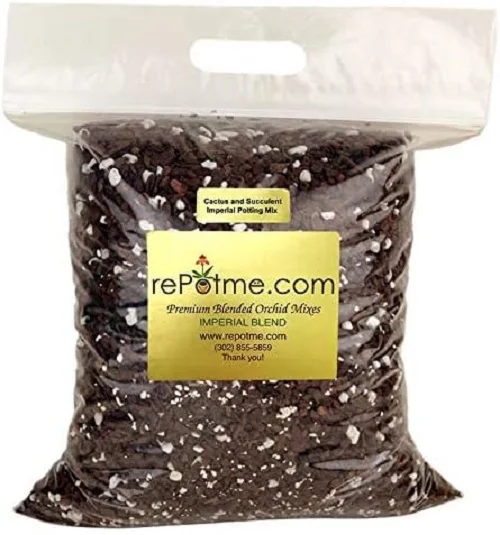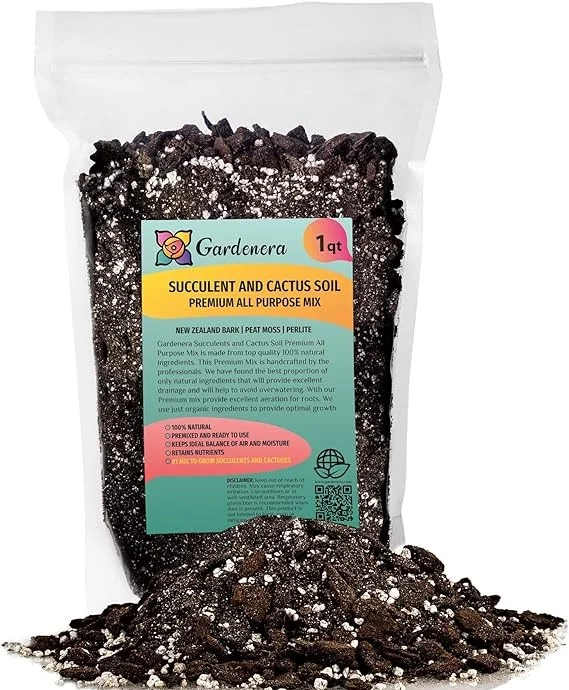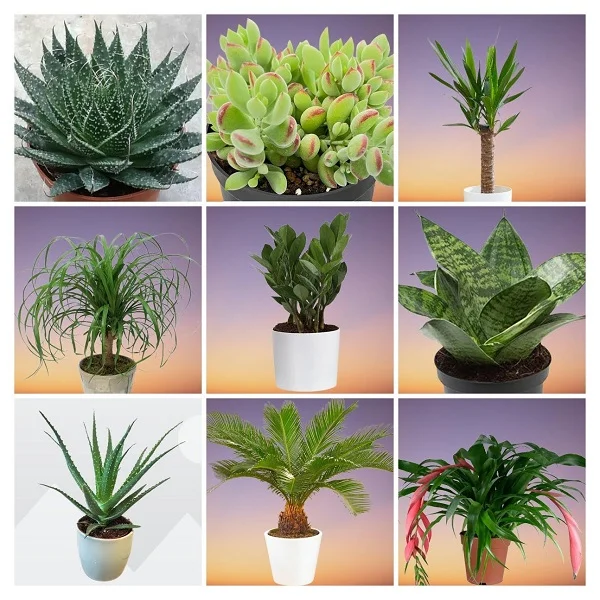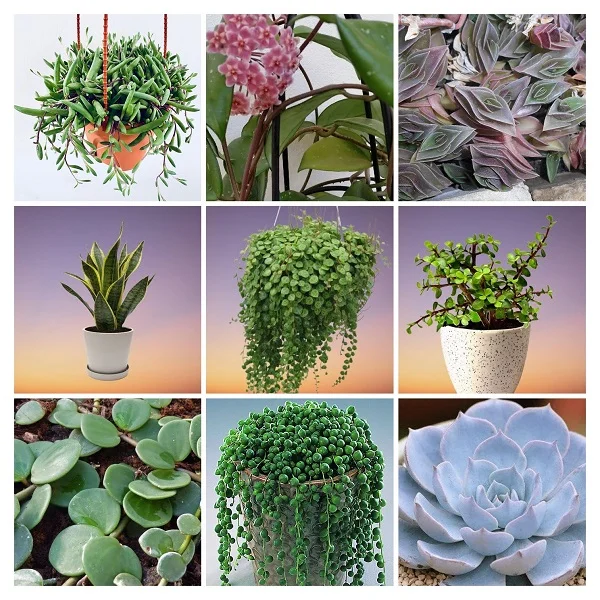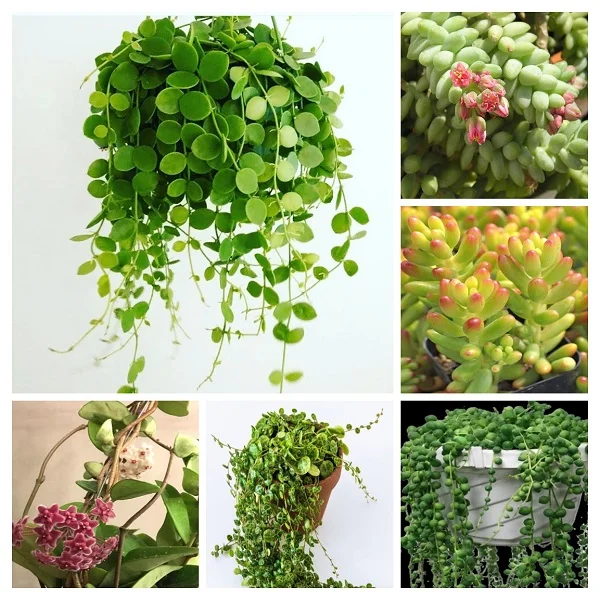String of Nickels Plant (Dischidia nummularia) Care Indoors, Propagations and Problems
Some links in this post may be affiliate links
String of Nickels Plant (Dischidia nummularia) grows best in bright light with some morning sunshine, average warmth, moderate humidity and moderately moist, rich, well-drained soil with two feedings in the growing season.
Dischidia nummularia also called Button Orchid is one of the popular string of plants with trailing stems and succulent leaves which form a dense mass of greenish-yellow foliage.
The stems can grow upto 3 metres long and cascade downwards beautifully placing it among the best plants for a hanging basket, a pedestal, a tabletop. a plant shelf or any where the stems can hang downwards.
The leaves are opposite and round and look like numerous coins, hence the common name "String of Nickels". The young leaves often have a powdery bloom. The flowers are white to yellowish-white.
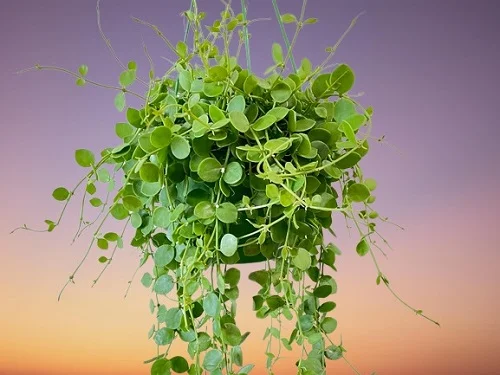
Botanical name: Dischidia nummularia
Family: Apocynaceae
Common names: String of Nickels Plant, Button Orchid
Origin
Dischidia nummularia is native to India, China, Thailand, Malaysia, Vietnam, Laos, Myanmar and Australia where it grows as an epiphyte on trees.
Is Dischidia nummularia toxic?
Yes. Dischidia nummularia is considered toxic to both humans and pets if ingested. It produces a milky sap which can irritate the skin. Always wear gloves when handling the plant.
Dischidia Varieties
• Million Hearts Plant (Dischidia ruscifolia) which bears numerous heart-shaped leaves on trailing stems and white, tiny and very fragrant flowers.
• Watermelon Dischidia (Dischidia ovata) which bears oval-shaped leaves with markings which resemble the rind of the watermelon fruit.
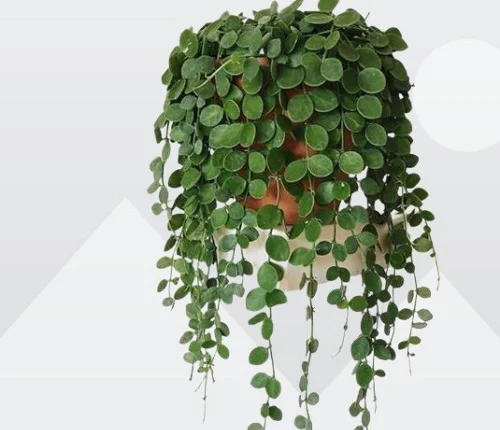
How to care for Dischidia nummularia indoors
To care for Dischidia nummularia indoors, give it bright light with 4-6 hours of morning sunshine, warmth of 18-260C, humidity of 50-55% and moderately moist, rich, well-drained soil with two feedings in the growing season.
String of Nickels Plant has no need for frequent repotting as it has a small root system. Pruning is needed to keep the plant neat, to discourage pests and diseases and to control growth. Keep reading for more on these growing conditions and how to achieve them.
Watering
How should I water String of Nickels Plant?
Dischidia nummularia cannot tolerate soggy soil. Ascertain that the pot has a drainage hole and the soil is free-draining to avoid rotting.
Water your String of Nickels Plant liberally until water comes through the drainage hole in spring and summer. Discard any excess water on the saucer or catch plant to prevent the soil from getting soggy.
Allow the top 2-3 inches of soil to dry out before the next watering to keep the soil moderately moist. Avoid overwatering to prevent rotting, yellowing and leaf drop.
In fall and winter, significantly decrease watering to maintain the soil barely moist as the growth is minimal at this time. However, do not allow the soil to dry out completely to avoid wrinkling and leaf fall.
Light Requirements
Does Dischidia nummularia need sunlight?
Yes. Dischidia nummularia thrives in bright light with 4-6 hours of morning sunshine. Ensure to place the plant infront of a large, bright window where it will receive some sunshine.
Low light will result in a leggy plant while direct hot sunlight will scorch the leaves. Therefore, if the natural light is not sufficient, use a grow light to supplement it.
Rotate the pot regularly to ensure that the plant gets light on all sides to prevent it from becoming leggy.
Temperature & Humidity
Dischidia nummularia does well in a moderate warmth of 18-260C. Keep it away from drafts as sudden changes in the temperature can cause stunted growth and leaf drop.
String of Nickels Plant prefers a humidity of 50-55%; it has no need for extra humidity. Ensure that there is good air circulation to prevent fungal diseases.
Fertilizer
What is the best fertilizer for String of Nickels Plant?
Feed your String of Nickels Plant with a slow release fertilizer in spring and summer as per the manufacturer's instructions. The plant is not a heavy feeder so be careful when feeding. Do not feed in fall and winter as growth is reduced at this time.
Potting Soil
What kind of soil do String of Nickels Plants like?
String of Nickels Plant likes a rich, loose, free-draining soil. The medium should be loose enough to allow water to drain out fast enough to prevent retention of excess water as the plant is prone to root-rot if the medium gets soggy. Most Cactus and succulents mixes are ideal for this plant.
Repotting
Dischidia nummularia has a small root system so frequent repotting is not necessary. Repot the plant at the beginning of the growing season only when it becomes crowded in its current pot.
Use a pot 1 size larger than the current one and ensure that it has a drainage hole. This is important to prevent the soil from getting soggy as it can lead to root-rot and death of the plant. Take care not to bury the stems to prevent rotting.
Use a shallow pot rather than a deep one as the plant has a small root system. You can select from these succulents pots available on Amazon.
How to prune Dischidia nummularia
Pruning Dischidia nummularia requires removal of any dead leaves and stems to keep the plant neat and tidy. This also helps in reducing pest and disease infestations.
Trim the stems at the beginning of the growing season if they become straggly to rejuvenate growth and encourage a fuller plant.
Dischidia nummularia Propagation
Dischidia nummularia is best propagated from stem cuttings at the beginning of the growing season when in active growth.
String of Nickels Plant propagation from stem cuttings
- Take 3-5 inches stem cuttings from a healthy plant. Ensure each cutting has 2-3 leaf nodes as this is where new growth will sprout from.
- Allow the cuttings to dry (callus) under a shade for about 7 days to avoid rotting.
- Fill a rooting container with loose, sandy soil and moisten it slightly. Ascertain that the container has good drainage to prevent rotting.
- Press the lower cut-end of the cutting into the soil or lay the string on top of the soil and lightly press the leaf nodes into the soil.
- Place the set up in a warm, well-lit place away from direct sunlight to prevent scorching.
- Maintain the soil moist until the cuttings are rooted and the plants are well established.
- When you observe substancial growth, transplant the new plant in well-drained succulents soil and begin routine care.
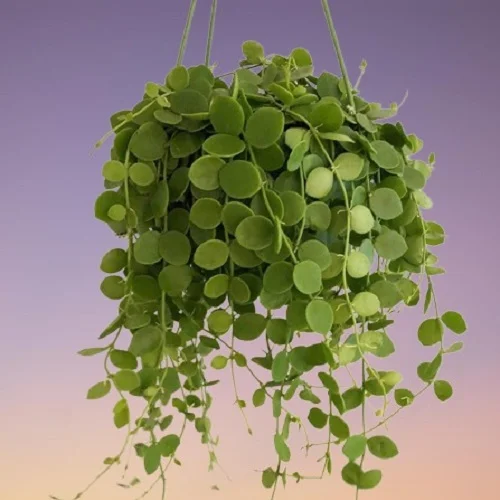
Dischidia nummularia Problems & Remedies
String of Nickels Plant problems are plant dying, dropping leaves, yellowing leaves, brown leaves, leggy growth, pests and diseases among others. Keep reading for more on these problems and how to fix them.
Plant dying
Why is my String of Nickels Plant dying?
Your String of Nickels Plant is dying due to too little light, inconsistent watering, soggy soil, nutrients deficiency, temperature stress, being pot-bound, root-rot, pests among others
Check out this post on 11 Reasons Why Dischidia Plant is Dying and How to Revive It.
Leaf loss
Why is my String of Nickels Plant losing leaves?
String of Nickels Plant is losing leaves due to use of cold water, underwatering, overwatering, low light, poor quality soil, temperature stress, pests, root-rot among others.
Read more on these 12 reasons why String of Nickels Plant is Losing Leaves and How to Solve Them.
Yellowing leaves
Why is my String of Nickels Plant turning yellow?
Your String of Nickels Plant may turn yellow due to inconsistent watering, insufficient light, cold drafts, nutrients deficiency, pests infestations, poor quality soil, being pot-bound among others.
Take a look at these 12 Reasons for String of Nickels Plant Yellowing Leaves & How to Fix Them.
Brown leaves
Why are my Dischidia nummularia leaves turning brown?
Some of the causes of brown leaves on your Dischidia nummularia are inconsistent watering, too little light, extreme temperatures, and aging.
How to fix it
Inconsistent watering: Do not water on a schedule. Water when the top 2-3 inches feel dry but do not let the soilball dry out completely.
Too little light: Position the plant in a brighter spot with 4-6 hours of morning sunshine.
Extreme temperatures: Protect the plant from drafts emanating from hot surfaces, AC units, windy doors, drafty windows and others.
Aging: With maturity the older leaves begin to die; they first turn yellow, then brown and eventually fall off.
Leggy growth
Leggy growth on String of Nickels Plant is due to overwatering and too little light.
How to fix it
Overwatering: Cut down on watering to maintain the soil barely moist in fall and winter.
Too little light: Move the plant in a brighter spot where it will receive bright light with 6-8 hours of direct sunshine or use a grow light if the natural lighting is not enough.
Pests
Common pests of Dischidia nummularia are spider mites, scale insects, aphids and mealybugs.
How to fix it
- Check underneath the leaves regularly for these pests and take timely control measures.
- Isolate the affected plant to prevent spread to other plants.
- Treat the infested plant with neem oil or insecticidal soap as per the manufacturer's instructions.
- Regularly damp-wipe the leaves with a soft cloth to discourage the pests.
- Maintain the plant well pruned to minimize the hiding and breeding grounds for these pests.
Diseases
String of Nickels Plant is prone to the following diseases:
1. Leaf spot disease which is characterized by brown, moist spots on the foliage. In a serious attack the spots can enlarge and merge, killing the whole leaf.
How to fix it
- Remove and burn the affected parts to reduce the risk of spread to the rest of the plants.
- Spray the affected plant with a systemic fungicide and ensure to follow the manufacturer's instructions.
- Keep the plant on the dry side and do not mist it for several weeks.
2. Powdery mildew which is a fungal disease and is prevalent in warm humid conditions. It is characterized by spotting or coating of the leaf surface with a white powdery deposit.
How to fix it
- Remove the affected leaves and discard to reduce spread to other parts of the plant.
- Spray the plant with a systemic fungicide as indicated by the manufacturer.
- Improve the air circulation for the plant as doing so reduces the occurrence of the disease.
3. Basal stem-rot disease which is brought about by overwet conditions. It is a fungal disease which spreads rapidly and kills the plant making it difficult to treat.
How to fix it
- To save a plant that is in the early stages of infestation, cut away and discard or burn the diseased tissue.
- Keep the soil on the drier side; avoid soggy soil by use of well-draining soil and a pot with a drainage hole.
- Ensure there is free air circulation for the plant.
- Avoid keeping the plant in very cold conditions.
- If the plant is too far gone, use the upper stems to propagate new plants and discard or burn the infected parts.
- Discard its pot and soil to prevent spread to the rest of the plants.
You liked it? Share on social media.
Related Content
Amazon Associates Disclosure
Homeplantsguide.com is a participant in the Amazon Services LLC Associates Program, an affiliate advertising program designed to provide a means for sites to earn advertising fees by advertising and linking to amazon.com.
